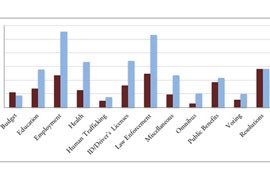Cronkite News has moved to a new home at cronkitenews.azpbs.org. Use this site to search archives from 2011 to May 2015. You can search the new site for current stories.
With SB 1070 in limbo, immigration bills fell sharply in states this year
WASHINGTON – No matter how it rules, the Supreme Court’s consideration of Arizona’s SB 1070 immigration law has already had one effect.
The number of immigration bills and resolutions proposed in state capitals fell sharply in the first quarter of this year, and analysts point to uncertainty over the Supreme Court’s decision as one possible reason.
“Many states are waiting on the Supreme Court ruling on the Arizona law,” said Michele Waslin, a senior policy analyst at the Immigration Policy Center. “It determines, to some extent, what states will do and what they can and can’t do.”
Until then, state lawmakers appear to have been holding their fire.
A recent report by the National Conference of State Legislatures said there was a 44 percent drop in immigration-related state proposals this year, the first decline since the numbers began a steady climb in 2005.
Immigration experts attributed the decrease to two major factors: Worry over the Supreme Court decision, which could come down next week, and the increasingly controversial nature of the bills.
The conference’s report said 865 bills and resolutions relating to immigrants and refugees were introduced into 45 state legislatures and the District of Columbia through March 31, down from 1,538 in the same period in 2011.
Arizona, for instance, introduced 57 immigration bills in the first quarter of last year, but just 33 this year, according to NCSL.
“There were trends that would catch like wildfire,” said Tamar Jacoby, the president of ImmigrationWorks USA. “One state would do something and the others would follow.”
Waslin said there was an expectation that a lot of states would introduce bills similar to SB 1070, which passed in 2010, but that didn’t happen.
The court’s decision, which is likely to be released before the court recesses for the summer at the end of next week, will give states an outline of what to expect when it comes to immigration legislation.
“It should provide guidance in the area,” said Peter Schuck, a law professor at Yale University.
While no one would predict that the court ruling would have a direct impact on the number of immigration bills filed, Waslin said it is “certainly a possibility” that the number could go back up if the Supreme Court upholds SB 1070.
But officials also said there may be another factor at work: State legislators may not have wanted to deal with the backlash immigration bills have caused in some states.
“This is an issue in which introducing legislation is likely to inflame as many opponents as rouse supporters,” Schuck said.
Politicians were not sure if introducing immigration legislation would be a “net benefit or net loss to them,” he said, because of a potential for voter reaction as immigration came to the forefront of a nationwide debate.
“There was an opposition from a wider array of people who weren’t speaking up before,” said Jacoby, whose organization advocates for immigration reform on behalf of a federation of small business owners.
Waslin agreed, saying there is little appetite for the type of “divisions these bills cause.”
Ann Morse, who prepared the report for the NCSL, said there were also logistical issues that may have played into the decrease as well. She noted that five states – Montana, Nevada, North Dakota, Texas and North Carolina – were not in session in the first quarter of 2012 and that the high cost of implementing these bills could also be a deterrent.
Whatever the reason, and whatever the outcome of the Supreme Court case, the experts said there is one other thing about immigration reform battles that is already certain: It’s never dull.
“It is very interesting,” Jacoby said.








